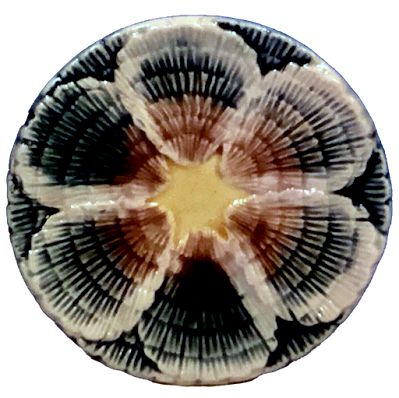One of the most significant things we uncovered in doing the research for our book, Etruscan Majolica: The Majolica of Griffen, Smith & Company is the true identity of the Etruscan pattern generally known as the "classical" pattern.
We really have no idea who came up with the pattern name "classical" but we do know that Charles Rebert popularized the term in his book American Majolica 1850-1900. From there it was picked up by Marianne Marks in her early majolica guides and from that point the term spread across the general majolica universe like wildfire. The same is true of the so-called "albino" wares. This is how misinformation is generally spread.
Until our books were released a few years ago there wasn't any real reason to call this "classical" series anything else but now that we have uncovered the real name of the series, "Pandora", this is how it should be properly referred to.
Pandora first appeared in the Etruscan line in 1886, two years after the 1884 International Cotton Exposition brought the company great good fortune. Designed by Etruscan Works master decorator W.H. Edge, the line was meant to expand the GSH catalog by offering a different line of earthenware from the gaudier majolica that was beginning to fall out of favor. Although the entire line was glazed using majolica lead glazes the company did not consider Pandora a majolica pattern. It was marked with the non majolica Good Strong and Handsome logo and was glazed in a variety of monochromatic and duo chromatic glazes, both with gold banding. Only a very small percentage of the line is marked with the GSH Etruscan Majolica logo and covered in multicolored glazes.
The pattern design is a complex one. The plates feature an intaglio representation of John Flaxman's sculpture, "Mercury bringing Pandora to Earth" in the center.
The bowls, compotes and other shallow serving pieces feature an intaglio representation of M.E. Rietschell's "Cupid and Panther."
Other pieces have intaglio designs of cockatoos and dogs on them. The borders of these pieces vary in their design. The largest plates have a complex lattice and shield design. The smaller plates and the hollowware have a faux alligator pattern on them. The large bowls copy a Wedgwood designed border of grape vines with leaves and fruit and the small bowls have a simple reeded border. The stand design is taken from the company's Morning Glory card stand with the Cupid and Panther motif substituted for the morning glories of the earlier majolica design. The tea wares have only the faux alligator pattern on them. The plates and serving bowls are much more common than the hollowware which is scarce.
The bowls, compotes and other shallow serving pieces feature an intaglio representation of M.E. Rietschell's "Cupid and Panther."
Other pieces have intaglio designs of cockatoos and dogs on them. The borders of these pieces vary in their design. The largest plates have a complex lattice and shield design. The smaller plates and the hollowware have a faux alligator pattern on them. The large bowls copy a Wedgwood designed border of grape vines with leaves and fruit and the small bowls have a simple reeded border. The stand design is taken from the company's Morning Glory card stand with the Cupid and Panther motif substituted for the morning glories of the earlier majolica design. The tea wares have only the faux alligator pattern on them. The plates and serving bowls are much more common than the hollowware which is scarce.
This rather eccentric combination of motifs is unified by the monochromatic and duo chromatic glaze treatments that are used across the entire line. Where the pattern can be found in a variety of colors, the most common monochromatic color used is a dusty rose, a color that compliments the faux alligator treatment of the hollowware. The most common duo chromatic treatment features a green center with a rose colored border. This treatment is similar to the Tremblay wares, a commonly used mode of decoration found in English and French intaglio ware.
The line is reported to have been quite successful in its day though that success has not translated to modern tastes. Along with the decorated earthenware made by the company, Pandora is not very popular today. This accounts for low prices across the board for all pieces in the line. A minor exception can be made for the Pandora plate with a dog on it, which has remained popular with dog lovers.
Ironically the only other popular piece is the centre bowl, the single Pandora designed piece that was most frequently decorated in multicolored glazes, the very glaze treatment it was made to replace.
Ironically the only other popular piece is the centre bowl, the single Pandora designed piece that was most frequently decorated in multicolored glazes, the very glaze treatment it was made to replace.
For more information on Pandora, as well as the other Etruscan patterns refer to our book, Etruscan Majolica: The Majolica of Griffen, Smith and Company, Volume 2.


































































